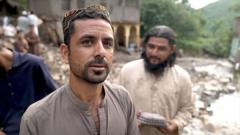In a scene reminiscent of previous calamities, villagers in Swabi district, Khyber Pakhtunkhwa, Pakistan, mourned as they uncovered the bodies of children trapped beneath rubble after devastating flash floods. Eyewitness accounts described an atmosphere heavy with anger and despair, fueled by a hope for more immediate government intervention. “Why didn’t the government warn us sooner?” was a sentiment echoed among those affected, fueling frustration in the face of limited support during such disasters.
Rescue attempts were hindered by the flood's ferocity, with calls for excavators left unfulfilled due to impassable roads. Amidst this tumultuous backdrop, emergency teams struggle to deliver the necessary aid, underlying a dire disconnect between governmental assurances and on-the-ground realities.
Distraught villagers, along with rescue teams, sifted through mud and debris, reflecting on the omnipresent threat flooding poses to their lives and homes. Since June of this year, over 750 lives have been lost to monsoon rains, a toll that echoes the catastrophic figures from 2022 when flooding killed approximately 1,700 and resulted in nearly $15 billion in damages. Experts warn that these tragedies will likely continue as climate change exacerbates Pakistan's already precarious situation.
Dr. Syed Faisal Saeed from the Pakistan Meteorological Department explains that the geographical attributes of Pakistan render it particularly susceptible to extreme weather events, including heavy rainfall, prolonged drought, and dangerous cloudbursts. Despite contributing less than 1% of global greenhouse gas emissions, the country finds itself bearing the brunt of climate change results, leading some lawmakers to articulate a sense of injustice, describing Pakistan as paying for "international sins."
A further complication arises from Pakistan's budgetary decisions. As the government faces competing priorities, the funds allocated to climate change initiatives remain disproportionately small compared to defense expenditures. Former Climate Minister Senator Sherry Rehman criticized this disparity, asking, “If we are not seen investing in our own resilience, why would others support us?” Funding inadequacies have resulted in extensive unfinished climate-related projects and delayed emergency responses.
Early warning systems are imperative to mitigate damage, but improvements are slow. The PMD is striving to enhance its forecasting capabilities with better technology, yet the rapid onset of weather events often leaves communities helpless. In rural areas, communication remains a significant obstacle, as many residents lack access to modern technology for warnings.
Moreover, lax construction laws exacerbate the problem; existing regulations prohibiting building near rivers are widely ignored. The deaths caused by such negligence illustrate the desperate need for comprehensive compliance, alongside potential relocation and support strategies for at-risk populations.
As Pakistan looks for international support following global climate discourse, particularly following the recent COP27 summit, the urgency for tangible results on the ground is critical. Initiatives for afforestation and community-focused resilience plans must be prioritized as local populations move forward amid ongoing threats from natural disasters.
Despite the pervasive hope for recovery, the path remains fraught with challenges. Experts highlight the need for grassroots education on sustainable practices to empower communities in their fight against climate impacts. In the villages of Swabi, the heartache of loss intermingles with the determination to advocate for survival, introspection becoming a necessity in the face of relentless monsoon seasons that reveal ongoing vulnerabilities and unresolved grief among Pakistan's most affected populations.


















